Introduction
Higher education institutions today confront major challenges, such as declining student enrollment, increased demands for personalized learning experiences, and administrative inefficiencies. Artificial Intelligence (AI) emerges as a powerful solution, driving innovation across academics, administration, and student engagement.
This comprehensive guide explores how AI technologies are transforming higher education, delivering tangible benefits, and addressing the nuanced challenges of implementation.
What is AI and Why Does It Matter in Higher Education?
Definition of AI and Its Core Technologies
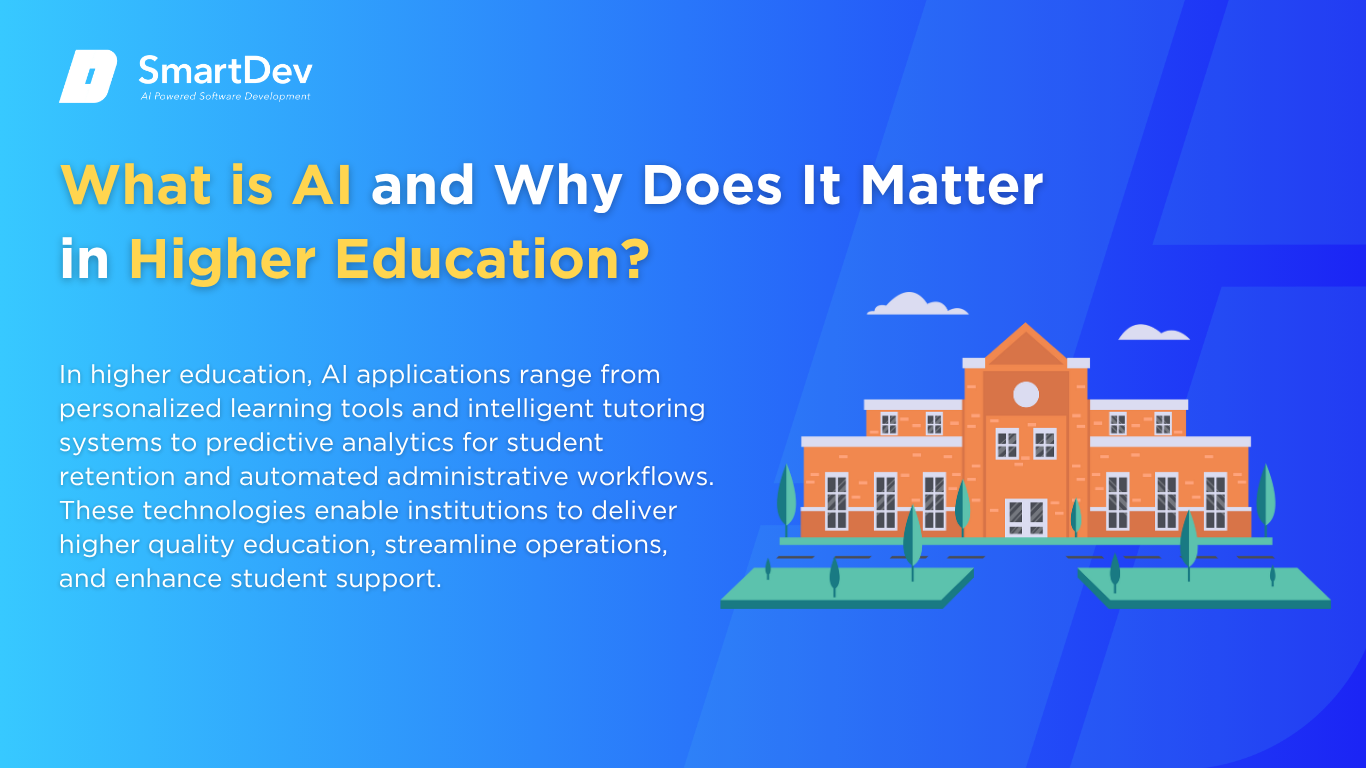
AI refers to machines and computer systems that simulate human intelligence processes, including learning, reasoning, and problem-solving. Essential technologies like machine learning (ML), natural language processing (NLP), and computer vision empower systems to analyze extensive educational data, predict student outcomes, and automate administrative tasks.
In higher education, AI applications range from personalized learning tools and intelligent tutoring systems to predictive analytics for student retention and automated administrative workflows. These technologies enable institutions to deliver higher quality education, streamline operations, and enhance student support.
The Growing Role of AI in Transforming Higher Education
AI is fundamentally reshaping higher education by enabling a shift from traditional, one-size-fits-all models to personalized, data-driven learning experiences. Adaptive learning platforms powered by AI dynamically adjust course content and difficulty levels based on individual student performance, significantly improving academic outcomes.
Moreover, AI is streamlining institutional operations through automated processes, from admissions and scheduling to financial aid distribution. This automation reduces manual workloads, minimizes human error, and frees up administrative resources for more strategic, student-focused initiatives.
AI also offers predictive capabilities that help universities anticipate and respond proactively to student needs. Predictive analytics models can identify students at risk of dropping out, allowing advisors and support services to intervene early, improving retention and graduation rates.
Key Statistics and Trends Highlighting AI Adoption in Higher Education
Adoption of AI in higher education is growing rapidly. The 2023 Horizon Report indicates that a substantial majority of higher‑ed institutions are actively exploring or deploying AI, especially in student support and administrative functions. This underscores increasing confidence in AI’s potential to enhance educational outcomes and institutional efficiency.
Research from McKinsey indicates that adopting AI-driven personalized learning solutions can improve student outcomes by up to 30%, directly translating into improved graduation rates and financial stability for institutions. These measurable benefits drive sustained investment and wider adoption.
The market potential for AI in education is substantial, projected by HolonIQ to reach approximately $6 billion by 2025, growing at a CAGR of 30%. This rapid market expansion reflects broad recognition of AI’s transformative power in higher education.
Business Benefits of AI in Higher Education
AI in higher education addresses core challenges by delivering tangible improvements across multiple domains:
 1. Enhanced Student Engagement
1. Enhanced Student Engagement
AI-powered learning platforms analyze student interactions to offer customized content and interventions, significantly boosting engagement. These platforms identify individual learning preferences and adjust content delivery, helping students feel more connected to their coursework. This tailored approach results in higher academic performance and sustained participation.
Increased engagement directly reduces dropout rates, as personalized support ensures students remain motivated and confident in their learning journey. Higher retention rates translate into long-term institutional stability and improved educational outcomes.
2. Improved Operational Efficiency
AI automates administrative tasks such as scheduling classes, processing applications, and managing financial aid. These streamlined processes free staff to focus on strategic tasks, enhancing overall operational effectiveness and service quality.
Fewer errors and quicker processing times improve institutional responsiveness and compliance. Consequently, institutions can better allocate resources to academic innovation and student-focused services.
3. Predictive Analytics for Student Success
AI predictive models analyze extensive student data to proactively identify those at risk of underperforming or dropping out. These insights enable targeted interventions, significantly improving student retention and success rates. Early detection and support prevent minor academic issues from escalating into major barriers to completion.
Improved student outcomes enhance institutional reputation, attract prospective students, and increase funding opportunities. Predictive analytics thus drives both immediate and long-term strategic benefits.
4. Personalized Learning Experiences
AI enables personalized learning by dynamically adapting educational content to individual student needs, skills, and learning styles. This personalization provides targeted support, helping students overcome specific challenges and excel academically. Students receive a more tailored educational experience, improving their satisfaction and performance.
Enhanced academic outcomes further validate institutional commitments to innovative teaching methods. Personalized learning also promotes equity by addressing diverse educational needs within the student body.
5. Efficient Resource Allocation and Campus Management
AI-driven systems optimize campus resources like classroom scheduling, energy consumption, and maintenance planning, significantly reducing costs. Efficient resource management contributes directly to institutional sustainability and financial health. AI ensures that resources are deployed effectively, reducing waste and optimizing expenditures.
These cost savings enable reinvestment into core academic programs, student services, and technological advancements. The strategic use of resources positions institutions for long-term growth and competitiveness.
Challenges Facing AI Adoption in Higher Education
Institutions adopting AI must navigate several critical and unique challenges:
 Data Privacy and Ethical Considerations
Data Privacy and Ethical Considerations
Higher education institutions manage sensitive student data, raising significant privacy and ethical concerns regarding AI analytics. Potential misuse or misinterpretation of data must be diligently managed to maintain regulatory compliance. Implementing comprehensive data governance policies is vital for safeguarding student information.
Transparent governance frameworks help build trust with stakeholders and mitigate ethical risks. Institutions must continually balance innovation with strict adherence to privacy standards and ethical best practices.
Integration with Legacy Educational Systems
Legacy Learning Management Systems (LMS) and student information systems in higher education often lack compatibility with advanced AI technologies. Integration difficulties can severely limit the functionality and effectiveness of AI tools. Overcoming these challenges requires significant technological investment in infrastructure and systems upgrades.
Institutions must develop or acquire middleware solutions or transition to more compatible cloud-based platforms. Without these improvements, the full potential of AI remains underutilized.
Faculty and Staff Resistance to Technological Change
Faculty and staff may resist AI integration due to concerns about job security, workload increases, or reduced autonomy in teaching. Resistance to change can significantly slow down or even halt AI implementation processes. To overcome these concerns, institutions must actively communicate the benefits and offer comprehensive training and support.
Engaging faculty and staff early and demonstrating clear advantages helps reduce resistance. A culture of collaboration and openness to technological innovation is crucial for successful AI adoption.
Algorithmic Bias and Fairness Issues
AI systems trained on historical data risk perpetuating institutional biases, especially in admissions or assessment practices. Unchecked biases can exacerbate existing inequalities rather than mitigating them. Institutions must regularly audit AI systems to identify and correct biases.
Interdisciplinary oversight and diverse data inputs are critical for ensuring AI fairness and equity. Vigilant monitoring and adjustment ensure AI aligns with institutional goals for diversity and inclusion.
High Costs and Unclear ROI
Adopting AI involves considerable upfront costs, including technology acquisition, staff training, and ongoing maintenance. Unclear or delayed returns on investment can deter institutions from fully embracing AI. Clear performance metrics and phased implementation strategies are essential for demonstrating value.
Measurable improvements in student outcomes and operational efficiencies justify continued investment. Structured evaluation processes help institutions manage expectations and validate the strategic value of AI initiatives.
Specific Applications of AI in Higher Education
 1. AI‑Powered Adaptive Learning Platforms
1. AI‑Powered Adaptive Learning Platforms
Adaptive learning platforms use AI to dynamically tailor educational content to individual student needs, addressing the one-size-fits-all limitation of traditional teaching. These systems analyze quiz results, assignment submissions, and engagement metrics to adjust difficulty levels and recommend tailored learning paths. Integrated into LMS (Learning Management Systems), they offer personalized pacing and topic reinforcement.
This approach improves knowledge retention and addresses individual weaknesses, enabling students to learn at their optimal pace. It also frees instructors to focus on deeper engagement rather than repetitive content delivery. Achieving this requires high-quality content metadata, robust student data pipelines, and seamless LMS integration.
Continuous feedback loops ensure that the AI adapts as students progress. Content alignment with curriculum standards must be maintained as AI updates learning paths. Data privacy and consent management are essential, especially when handling individual performance data.
Real‑World Example:
Carnegie Learning’s adaptive math platform uses AI to analyze student responses and adjusts practice problems in real time. It has demonstrated a 3‑grade equivalent gain after one semester of use. This platform is integrated into school LMS systems, providing teachers with dashboards to guide targeted interventions.
2. AI‑Enhanced Academic Integrity Detection
Higher education institutions face growing challenges in detecting plagiarism and AI-generated writing, which traditional tools may miss. AI-enhanced integrity systems use advanced NLP and stylometry to compare submissions against known writing patterns and detect anomalies. These tools are integrated with LMS to flag potentially compromised work for review.
Such systems support academic honesty and uphold institutional standards by identifying unusual writing shifts and inconsistencies. They also assist faculty by providing scoring confidence levels and editing patterns. However, ensuring fairness and avoiding wrongful flags is a key technical consideration.
Calibration against diverse student writing styles is necessary to prevent false positives. Clear communication to students about how their work is evaluated is also crucial. Ongoing human-in-the-loop review helps refine detection thresholds.
Real‑World Example:
Turnitin has introduced an AI-writing detection module powered by NLP to identify text generated by tools like ChatGPT. Early studies show over 90% accuracy in identifying AI-authored segments in student essays. The system integrates directly with common LMS platforms to streamline instructor review workflows.
3. Intelligent Tutoring and Chatbots
Universities often struggle to provide scalable and consistent academic support outside classroom hours. Intelligent tutoring systems and chatbots offer on-demand guidance, answering student questions, providing explanations, and suggesting resources. These AI-powered tools are embedded within course portals and messaging apps to ensure accessibility.
By offering 24/7 academic support and clarifications, they reduce barriers to learning and relieve administrative load on staff. Their consistent, unbiased responses help maintain service quality across all users. The challenge lies in training chatbots with comprehensive course content and ensuring correct responses.
Regular monitoring and student feedback help improve tutor accuracy. Escalation protocols direct complex inquiries to human tutors. Ethical considerations include ensuring transparency that students are interacting with AI—not human tutors.
Real‑World Example:
California State University implemented ChatGPT-based chat assistance across its 23 campuses, offering students around-the-clock tutoring help. Surveys reported a substantial drop in elementary query traffic to human advisors. Student satisfaction scores also rose, with users appreciating responsiveness and relevance.
4. Automated Essay Grading and Feedback
Grading written assignments at scale can be time-consuming and inconsistent across instructors. AI-powered grading tools apply NLP and machine learning to evaluate essays, detect structure, grammar, and argument flow, and provide instant feedback. These systems integrate with LMS platforms to streamline grading workflows.
Automated grading accelerates turnaround time and offers consistent evaluation, enhancing student learning through rapid formative feedback. It also frees faculty to focus on higher-order teaching and mentoring. However, limitations include handling creative writing, nuance, and context-specific criteria.
Transparency in how essays are evaluated is critical for student trust. Systems must align with institutional rubrics and allow instructor oversight. Ethical safeguards must also prevent overreliance on AI for high-stakes assessments.
Real‑World Example:
The Open University in the UK implemented an AI-based grading assistant to support faculty in assessing thousands of essays. It reduced grading time by 40% and provided feedback aligned with course rubrics. The system supported instructor judgment while speeding up assessment cycles.
5. AI‑Driven Enrollment and Retention Prediction
Universities often struggle with student dropout rates and enrollment forecasting, which affect planning and funding. AI models trained on demographic data, academic performance, and engagement behaviors predict which students are at risk of dropping out. These insights enable proactive interventions from advisors and support staff.
Early alerts allow institutions to offer targeted support like tutoring, counseling, or financial aid. Accurate enrollment forecasting also aids in course scheduling and resource allocation. Data completeness and fairness must be considered to avoid reinforcing biases in predictive outcomes.
Predictive models should be transparent and explainable to support ethical decision-making. Intervention strategies must be student-centered and non-punitive. Institutions must secure student consent when using sensitive personal data.
Real‑World Example:
Georgia State University used AI analytics to identify students at risk of attrition through 800 predictive markers. The university implemented proactive outreach and support, resulting in a 34% increase in graduation rates. Their system is credited with closing achievement gaps for underserved students.
6. Virtual Teaching Assistants
As class sizes grow, universities often lack adequate teaching assistants to support learners. Virtual TAs powered by AI provide answers to routine questions, explain lecture content, and help with assignments through conversational interfaces. These tools are embedded in LMS platforms and messaging systems to maximize reach.
They help students get timely answers, especially outside business hours, and lighten faculty workload. Virtual TAs maintain consistency in responses and scale well across large enrollments. Challenges include ensuring factual accuracy and contextual relevance.
Ongoing updates and faculty oversight are essential to maintain instructional quality. Students should be informed when interacting with AI rather than humans. Institutions must monitor usage to ensure inclusivity and accessibility.
Real‑World Example:
Georgia Tech piloted “Jill Watson,” an AI teaching assistant built using IBM Watson, to respond to thousands of forum questions in an online course. Students couldn’t distinguish the AI from human TAs and received 24/7 support. The initiative allowed faculty to focus on high-level teaching tasks while maintaining quality student interactions.
 Examples of AI in Higher Education
Examples of AI in Higher Education
Real-World Case Studies
1. University of Reading: AI‑Generated Exam Papers
When University of Reading tested 100% AI‑generated exam answers via GPT‑4, they discovered that 94% went undetected—highlighting major vulnerabilities in academic integrity. This blind “Turing test” revealed that traditional plagiarism software and human checkers were ineffective against AI‑authored content. It raised urgent questions about existing examination systems and their ability to distinguish genuine student work.
The university responded by piloting AI‑resistant assessments and experimenting with oral exams and practical tasks that demand critical thinking. Faculty also adopted AI-detection tools and restructured assignments to include reflective and experiential components. These reforms aim to combine AI awareness with assessment innovation to preserve academic integrity.
As a result, Reading’s findings spurred UK institutions to introduce stronger policies, redesign coursework, and invest in new detection approaches. Students are now more often assessed via interactive or supervised formats. This case underscores the necessity for assessment reform in an increasingly AI-enabled learning landscape.
2. California State University (CSU): Scaling Tutor Chatbots
CSU introduced a customized ChatGPT Edu system across its 23 campuses to improve student outcomes and operational efficiency for over 460,000 users. Their goal was to provide daily access to AI-driven support for tutoring, study guides, and research assistance. Integrating ChatGPT into the digital ecosystem required careful deployment planning, usage tracking, and user training.
The AI chatbot offers real-time help with coursework, logs usage metrics, and routes complex queries to human staff. It became a 24/7 educational companion, accessible across multiple platforms and automatically linked to learning resources. Faculty monitored usage and provided feedback to refine responses.
After rollout, CSU saw a sharp increase in student engagement and a decrease in routine support requests to staff. Staff and students highly rated the AI assistant’s relevance and timeliness. The system also laid the groundwork for AI-literate campus culture and future innovation.
3. University of Sydney: ChatGPT as “Best Teammate”
At the University of Sydney, students like Jack Quinlan adopted ChatGPT as a virtual team member during group projects, prompting faculty to formally integrate it into the curriculum. The goal was to leverage AI for creativity, problem-solving, and writing support while enforcing responsible use policies. They developed ethical guidelines to guide AI usage and ensure originality.
Instructors used AI-generated drafts as teaching tools to help students critique and expand content, emphasizing critical thinking over content generation. AI was also used in innovative projects—such as VR explorations of rare books—to complement human creativity. The integration focused on augmenting student capabilities rather than replacing human insight.
When evaluated, students reported enhanced efficiency and deeper learning, especially in ideation and structural clarity. Ethical awareness also improved; more students acknowledged AI while citing responsibly. This case illustrates a balanced AI approach that enriches learning without undermining academic values.
4. Northumbria University: Ethical, AI‑Powered Research Innovation
Northumbria University launched the PROBabLE Futures project, focusing on responsible AI applications in areas like law enforcement, healthcare, and sustainability. The initiative included practical tools—such as asthma detectors and solar‑to‑water systems—demonstrating AI’s societal impact. Their AI checklists are now used by UK police to govern ethical deployment.
Interdisciplinary research teams tested and validated these tools in real‑world contexts, embedding transparent protocols and continuous stakeholder feedback. They emphasized ethical design, accountability, and real-world efficacy in all pilot programs. The result is scalable AI applications that prioritize fairness and public trust.
Outcomes included improved diagnostic accuracy for respiratory disease and water generation solutions for underserved communities. The ethical frameworks from PROBabLE Futures influenced national standards for AI transparency. Northumbria’s work exemplifies how higher education can drive responsible AI innovation for societal good.
Innovative AI Solutions
Adaptive Learning Platforms leverage AI to personalize educational pathways. By continuously analyzing student responses and performance, these systems adjust content difficulty and sequence to meet individual needs. Research shows 86% of studies report improved learning outcomes with adaptive technologies.
Intelligent Tutoring Systems (ITS) act like virtual tutors, providing custom feedback, quizzes, and intervention strategies without constant human supervision. Platforms such as Carnegie Learning’s algebra tutor and SQL‑Tutor have proven effective in boosting student understanding. They emulate one‑on‑one tutoring at scale, supporting mastery through iterative interaction.
LLM‑Powered Course Assistants like AI‑U fine‑tune large language models on course-specific materials (lectures, notes) to deliver targeted responses and guided learning. A recent system achieved 86% alignment with expert answers and outperformed base LLMs in graduate‑level queries. This LLM framework maintains linkage between responses and source material, promoting transparency and traceability in AI interactions.
AI-Driven Innovations Transforming Higher Education
Emerging Technologies in AI for Higher Education
Generative AI in Content Creation and Course Design
Generative AI technologies are revolutionizing higher education by automating the creation of personalized educational content, course materials, and interactive media. Universities such as Stanford and MIT are already leveraging AI-powered platforms like OpenAI and Adobe’s AI integrations to efficiently produce engaging, customized learning experiences.
Additionally, generative AI facilitates rapid testing and refinement of course designs, significantly reducing development time and cost. This allows institutions to swiftly adapt to student feedback and emerging educational trends, maintaining competitive and effective course offerings.
Computer Vision in Campus Management and Online Exams
Computer vision technologies are enhancing campus operations and academic integrity by automating attendance tracking, campus security, and online exam monitoring. Institutions like the University of Michigan use AI-powered surveillance systems to maintain campus safety and streamline facility management.
In online examinations, computer vision tools monitor student behavior to detect potential academic dishonesty, ensuring fairness and reliability in assessments. This boosts institutional credibility and enhances the overall learning environment.
AI’s Role in Sustainability Efforts
Minimizing Waste with Predictive Intelligence
AI-driven predictive analytics play a critical role in reducing resource waste across higher education institutions by accurately forecasting campus needs and optimizing resource allocation. These predictive tools significantly decrease unnecessary energy usage, food waste, and material consumption, resulting in cost-effective and environmentally friendly operations.
Greener Operations Through AI-Powered Energy Management
AI systems are effectively managing energy use across university campuses by automating real-time adjustments in heating, cooling, lighting, and energy distribution. By integrating these advanced AI technologies, universities are successfully meeting their sustainability targets without compromising operational effectiveness, creating greener and more sustainable educational environments
How to Implement AI in Higher Education
 Step 1. Assessing Readiness for AI Adoption
Step 1. Assessing Readiness for AI Adoption
Before integrating AI, higher education institutions must identify areas within their operations that could benefit most from intelligent automation. Common opportunities include personalized learning, predictive student success analytics, campus resource management, and examination integrity. Pinpointing critical issues such as low student retention, inefficient resource use, or administrative bottlenecks will highlight where AI can deliver substantial improvements.
Additionally, institutions should assess their technological maturity and infrastructure compatibility. Ensuring systems integration capability and access to relevant data sources, such as student records, LMS platforms, and campus facility data, is essential. A robust digital foundation significantly enhances the impact and effectiveness of AI implementations.
Step 2. Building a Strong Data Foundation
AI solutions in higher education depend heavily on high-quality data, making rigorous data management practices vital. Institutions should centralize and standardize diverse data streams, including academic performance, administrative operations, and campus management—into comprehensive, cohesive datasets. Accurate, consistent data significantly enhances the predictive accuracy and decision-making effectiveness of AI systems.
Moreover, clear data governance policies should be established to maintain compliance with privacy regulations and internal data security protocols. Regularly updating, validating, and maintaining these data sets ensures AI models reflect current institutional realities and evolving educational contexts, converting raw data into strategic insights.
Step 3. Choosing the Right Tools and Vendors
Selecting suitable AI platforms and vendors involves aligning solutions with institutional size, goals, and challenges. Whether seeking AI tools for student analytics, virtual tutoring, or smart campus management, compatibility with existing technology ecosystems is critical. Institutions should prioritize scalable, integrable, and user-friendly solutions, backed by robust support structures.
Partnering with vendors experienced in higher education contexts can facilitate smooth onboarding and quicker implementation. Reviewing case studies from similar institutions and assessing vendor adaptability to specific educational workflows will significantly improve integration success and ensure early, measurable benefits.
Step 4. Pilot Testing and Scaling Up
Starting AI implementation with pilot projects allows higher education institutions to evaluate AI performance in controlled, lower-risk settings. For example, an institution may initially deploy AI-driven student success analytics within a single department before institution-wide adoption. This approach identifies potential challenges, calibrates AI models accurately, and assesses return on investment.
Upon successful pilot validation, institutions should plan a structured scaling strategy. This involves defining clear benchmarks, providing staff training, allocating resources effectively, and rolling out AI systematically across broader operational areas. Structured scaling ensures AI adoption is sustainable and positively impactful.
Step 5. Training Teams for Successful Implementation
Effective AI integration in higher education hinges significantly on human factors, requiring comprehensive training programs. Faculty, administrative staff, and management should understand AI functionalities and interpret generated insights accurately, enabling informed decision-making and workflow adjustments.
Continuous education initiatives, such as workshops, webinars, and digital courses, keep teams proficient as AI evolves. Fostering an institutional culture that encourages curiosity, innovation, and openness to technology positions AI as an empowering resource rather than a disruption. This cultural shift is fundamental to achieving enduring educational and operational advancements.
Measuring the ROI of AI in Higher Education
Key Metrics to Track Success
Evaluating the return on AI investment in higher education involves monitoring student success rates, operational efficiency, and resource optimization. AI applications in adaptive learning, predictive analytics, and campus management improve student retention, streamline administrative tasks, and significantly reduce manual workloads. These enhancements lead to improved academic outcomes and decreased operational expenses.
Financially, institutions benefit from reduced administrative costs, enhanced resource allocation, and higher efficiency in facility management through AI-driven solutions. For example, predictive analytics tools help minimize student attrition and maximize enrollment retention, protecting institutional revenue and optimizing budget utilization. Such improvements directly contribute to the institution’s financial health and operational agility.
Case Studies Demonstrating ROI
Georgia State University utilized AI-powered predictive analytics to identify and proactively support at-risk students, achieving a substantial reduction in dropout rates and increasing graduation rates significantly. Similarly, Arizona State University deployed AI-driven campus management systems, resulting in measurable reductions in energy costs and operational expenses, saving millions annually.
Another notable case is Southern New Hampshire University (SNHU), which leveraged AI-driven adaptive learning systems, significantly boosting student engagement and academic performance. These examples illustrate how strategic AI investments in higher education deliver tangible improvements in student success, operational savings, and institutional growth.
Common Pitfalls and How to Avoid Them
A frequent challenge in higher education AI implementation is neglecting the critical importance of accurate and comprehensive data management. Incomplete or inaccurate data can lead to unreliable AI predictions, ineffective interventions, and suboptimal decision-making. Institutions must prioritize establishing rigorous data governance frameworks and continuously validate data integrity.
Additionally, institutions often make the error of deploying AI solutions without comprehensive stakeholder alignment and training. Faculty and administrative resistance may arise due to inadequate training or limited involvement in decision-making processes. To mitigate these issues, educational leaders should foster inclusive, cross-departmental AI implementation strategies, emphasizing clear communication, thorough training, and collaborative oversight throughout the AI adoption lifecycle.
Future Trends of AI in Higher Education
Predictions for the Next Decade
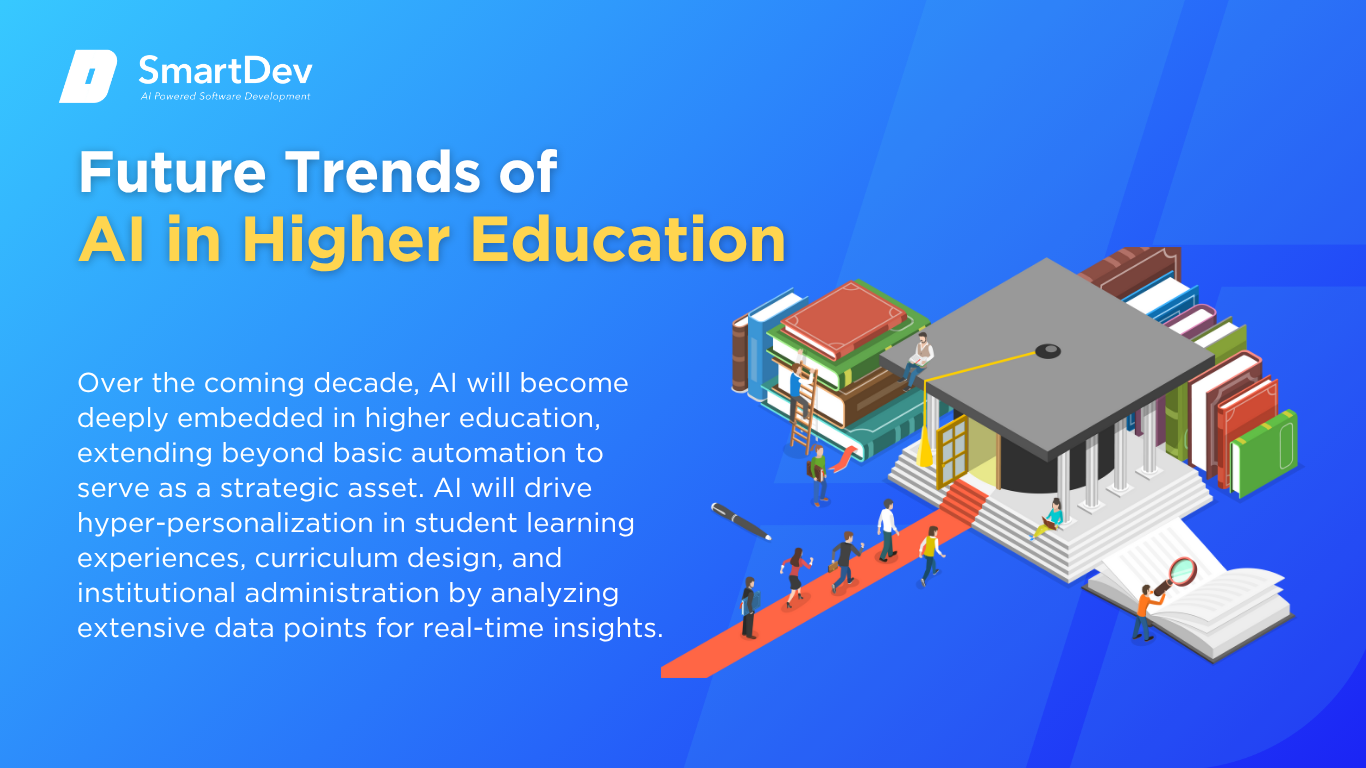
Smaller and regional institutions will increasingly access sophisticated AI tools, enabled by cloud-based platforms that democratize these technologies. Innovations such as AI-driven course creation, advanced student engagement analytics, and intelligent campus operations will become commonplace. Additionally, increased regulation around AI ethics, transparency, and data privacy will require institutions to deploy AI responsibly and transparently across all operational layers.
How Businesses Can Stay Ahead of the Curve
To remain competitive, higher education institutions must prioritize AI literacy and foster agile, data-informed cultures. Equipping faculty and administrative staff with the skills to utilize and interpret AI tools will be as essential as the technologies themselves. Cross-departmental collaboration between academics, IT, student services, and administrative functions will be critical for effective AI integration.
Forward-thinking institutions will view AI adoption as an ongoing developmental process rather than a static investment. Regular pilot programs, outcome assessments, and flexible adaptation of AI tools will be necessary to keep pace with changing educational landscapes. Institutions that successfully merge human expertise with AI capabilities will not only future-proof their operations but also pioneer transformative educational models.
Conclusion
Key Takeaways on AI Use Cases in Higher Education
AI is fundamentally transforming higher education by enhancing personalized learning, optimizing institutional operations, and boosting student success metrics. From adaptive course materials and predictive analytics to smart campus management, AI solutions significantly enhance efficiency, sustainability, and responsiveness to student needs. As demonstrated by case studies, AI consistently delivers measurable benefits in terms of cost savings, operational improvements, and enhanced educational outcomes.
However, fully realizing AI’s potential demands strategic preparation and meticulous execution. Establishing robust data infrastructure, selecting appropriate technologies, and cultivating skilled, AI-literate teams are essential components for long-term success. Institutions proactively investing in integrated, ethical AI frameworks will lead in the rapidly evolving higher education sector.
Moving Forward: A Path to Progress
If you’re leading an educational institution seeking improved student outcomes, streamlined operations, or advanced personalization in learning, now is the ideal moment to explore AI solutions. Begin with targeted pilot projects in high-impact areas such as student success analytics or campus resource management to build confidence and validate ROI. Don’t allow competitors to surpass you by implementing smarter, more adaptive educational technologies first.
At SmartDev, we partner with higher education institutions to harness AI, from optimizing academic performance to enhancing administrative efficiency. Whether you are initiating your AI journey or scaling existing solutions, we deliver customized approaches tailored to your unique institutional needs and technological infrastructure.
—
References:
-
Half a Million Students Given ChatGPT as CSU Makes AI History | Forbes
-
AI-Generated Exam Answers Go Undetected in Real-World Blind Test | University of Reading
-
Researchers Fool University Markers with AI-Generated Exam Papers | The Guardian
-
2023 Horizon Report: Teaching and Learning Edition | EDUCAUSE

 1. Enhanced Student Engagement
1. Enhanced Student Engagement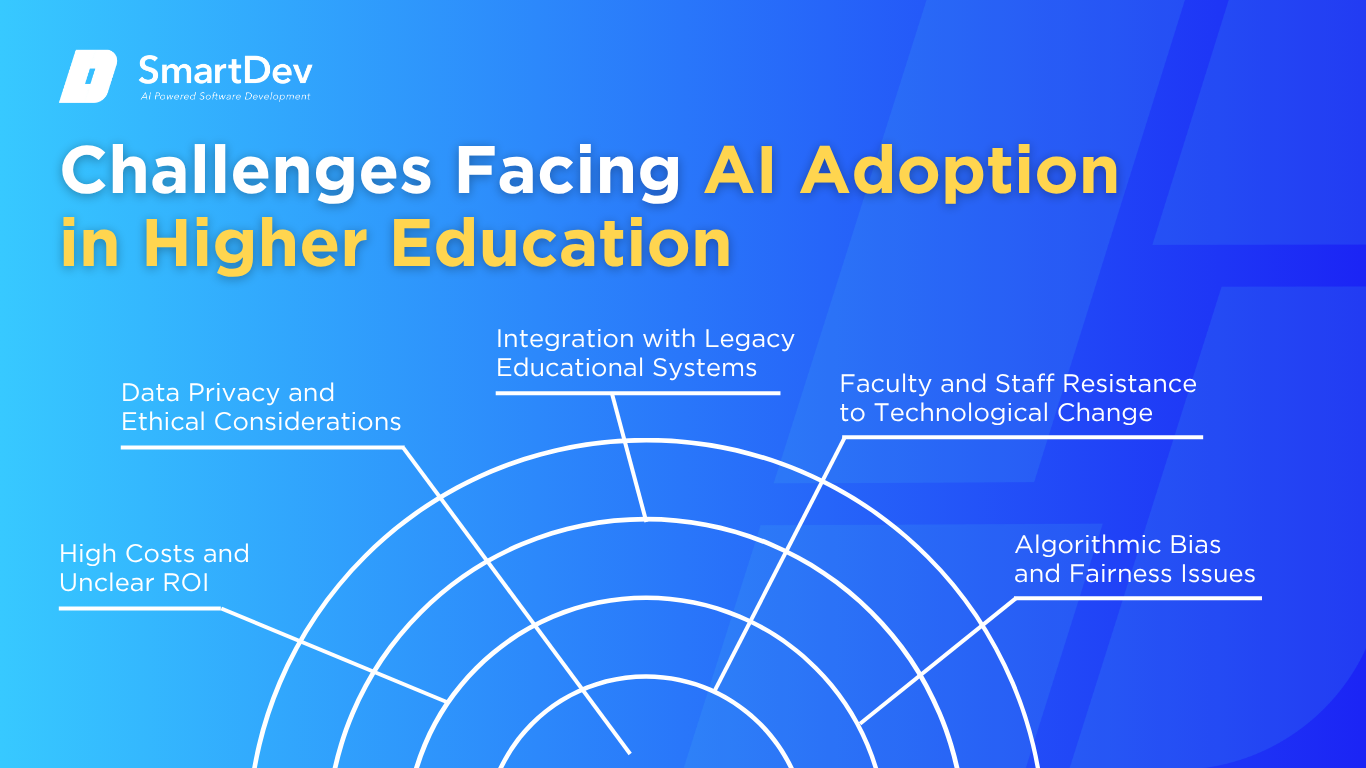 Data Privacy and Ethical Considerations
Data Privacy and Ethical Considerations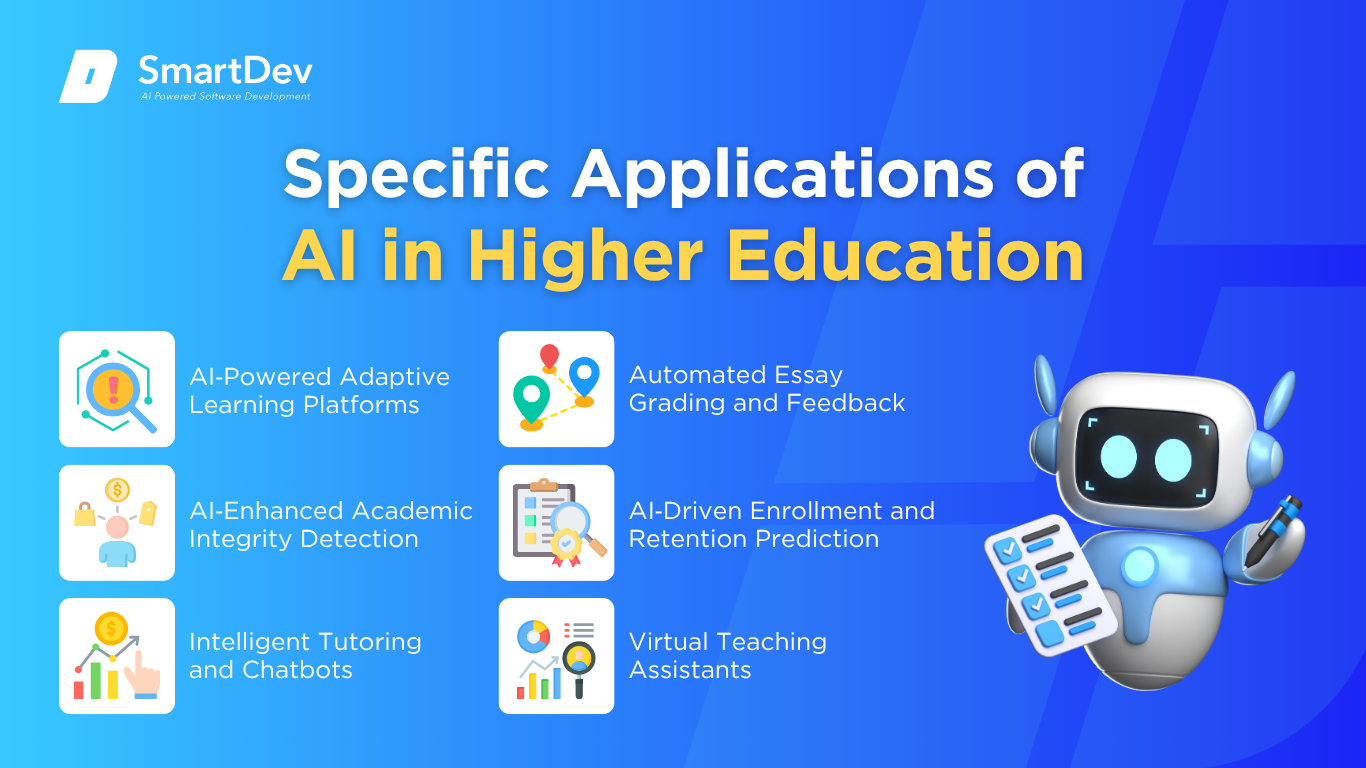 1. AI‑Powered Adaptive Learning Platforms
1. AI‑Powered Adaptive Learning Platforms Examples of AI in Higher Education
Examples of AI in Higher Education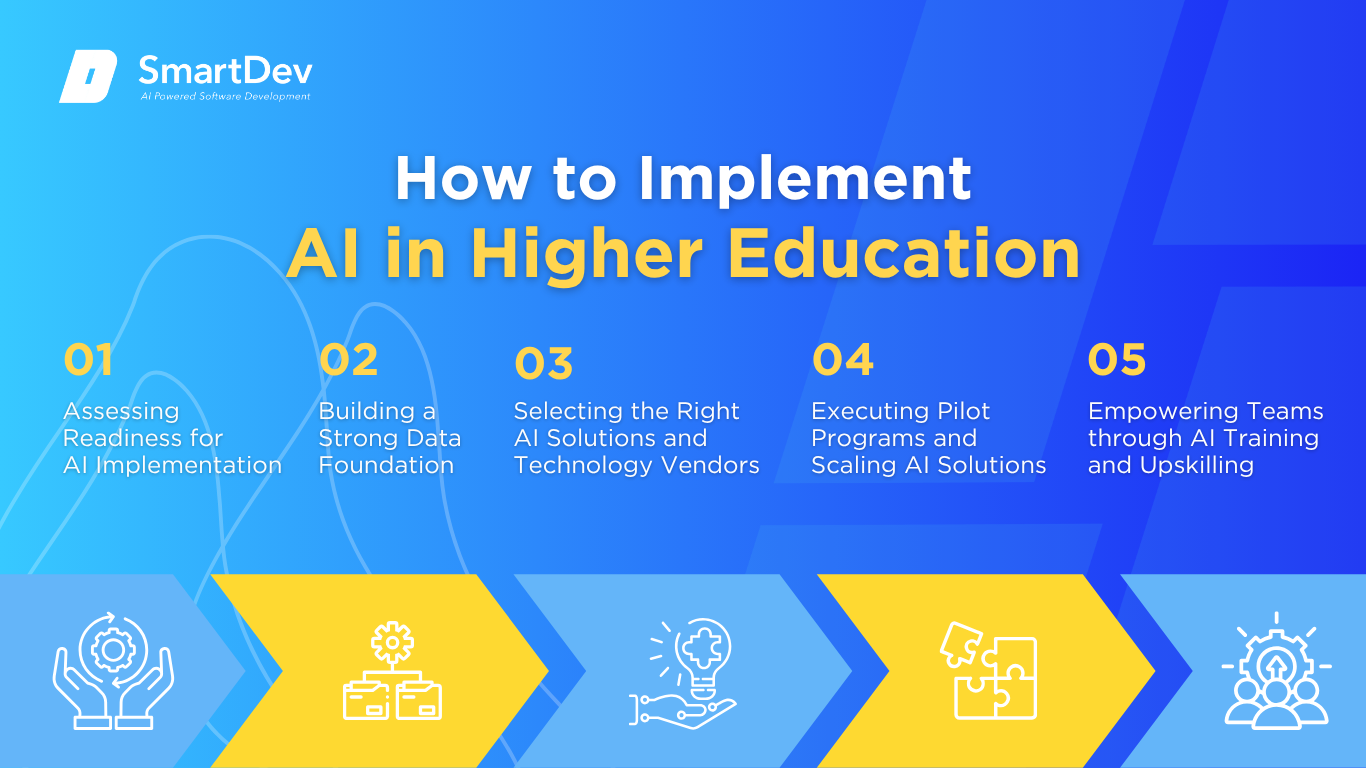 Step 1. Assessing Readiness for AI Adoption
Step 1. Assessing Readiness for AI Adoption





